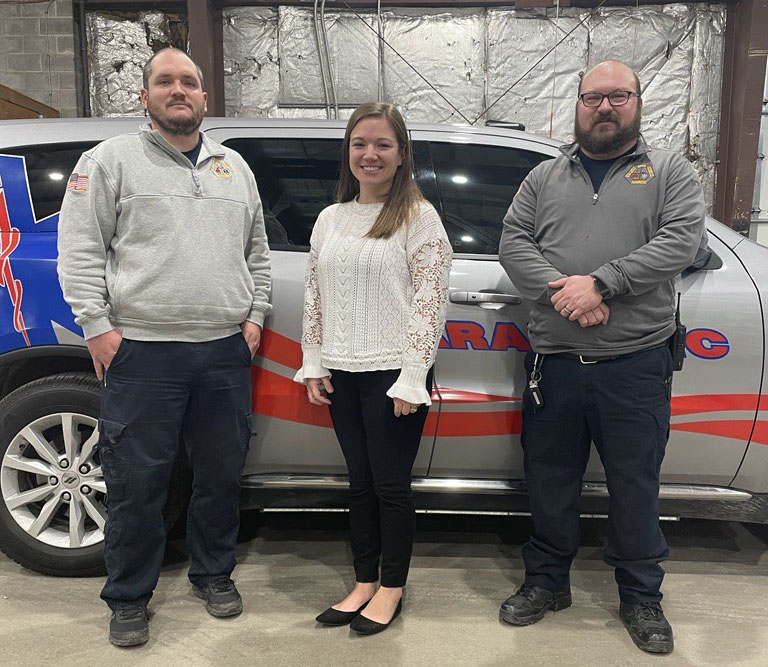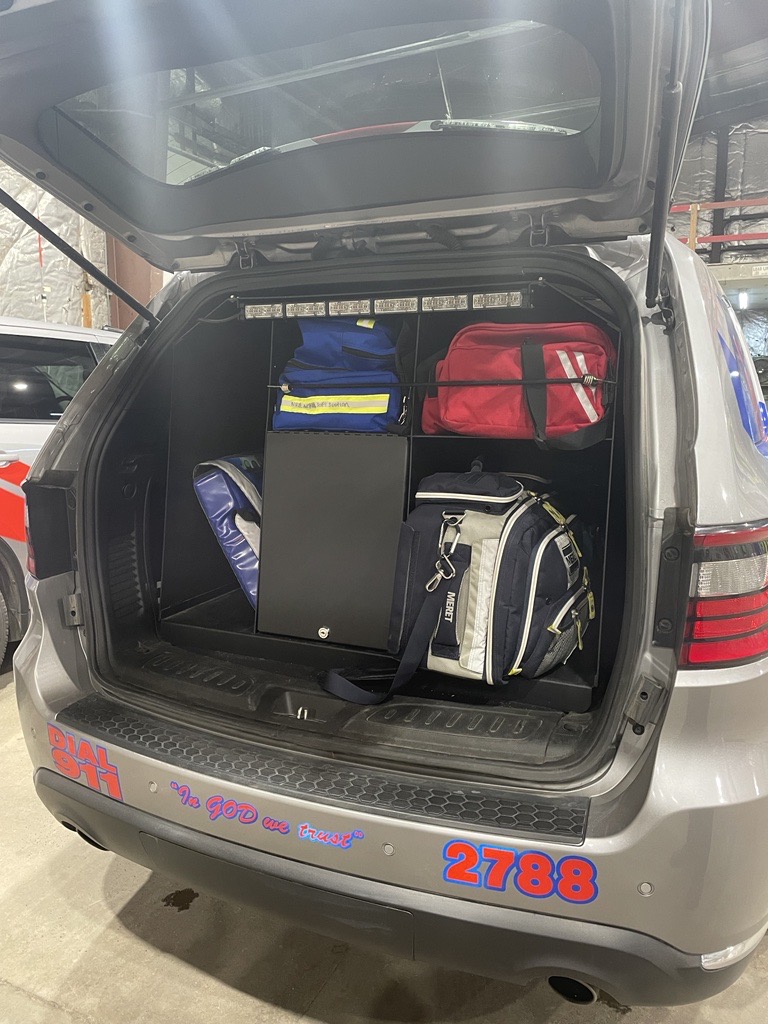If you happen to be especially fortunate in life, there’s at least a slim chance you’ll never need the services of an emergency medical technician (EMT).
And if you happen to be especially fortunate in life, there’s a chance – should you need one - that you’ll encounter an EMT like Justin Harrison, whose years spent on an ambulance and in emergency services have undoubtedly changed and saved lives in the Hoosier community that depends on him, and those like him.
Luck likely has little to do with the public health work Harrison and his fellow paramedics perform on each run and each shift. They’re the heartbeat of a rural community; always among the first on scene to help others in life-or-death situations – the very definition of neighbors helping neighbors.
But a new grant program is helping Harrison and others of New Castle-Henry County EMS serve their communities in ways that go beyond the traditional scope of EMS work. And thanks to that grant, Harrison and his crew are connecting with their neighbors in impactful ways, making a real difference for the people they live among and strive to serve.

Photo caption: New Castle EMS director Justin Harrison, IDOH HIPP regional coordinator Amiee Ingram, and paramedic Kevin Kimmerling are pictured here with a vehicle similar to the Chevrolet Tahoe the EMS crew was able to purchase through an IDOH Health Issues and Challenges grant.
A way of life
One of New Castle’s signature sights for residents and passersby alike is the Indiana Basketball Hall of Fame.
Located a stone’s throw off SR 3 in Henry County, this shrine to all things Hoosier hoops is about as hard to miss as the enormous gym shoe that adorns the museum’s front lawn. The supersized sneaker is something of a symbol of the New Castle community, with an identical high-top situated down the road a way at the Steve Alford All-American Inn, a cozy locale bearing the namesake of a local (and Indiana University) b-ball legend.
It’s a largely rural community beyond the limits of a city of about 17,000 that, in just about every way, embodies “Anytown, Indiana” – from its enduring love of basketball to its seemingly endless stretches of cornfields and country roads.
But, like the many small cities and towns that resemble it, Henry County is not exempt from the many challenges in the public health space most agricultural communities face today. Often, rural communities are among the most medically underserved, and of Indiana’s 92 counties, 72 are classified as predominantly rural.
Problems include a lack of critical access hospitals leading residents to turn to EMS for non-emergency medical services. Of course, there are only so many paramedics and ambulances to go around and calling 9-1-1 for assistance with an illness that could be treated at an urgent or primary care practice, or even medication issues, ties up a valuable human resource that is already in limited supply.
Big dreams
Challenges like these led longtime EMT Amiee Ingram to wonder, “what if?”
Ingram joined the Indiana Department of Health’s (IDOH) Health Innovation Partnerships and Programs (HIPP) division in August 2022, taking on the role of community paramedicine program lead, and she did so with a big dream.
“What if we could reach every person who falls through the cracks of health care?” she’d pondered.
State Rep. Anne Vermillion (R-Marion), a friend of Ingram’s, pondered the same and ended up authoring the bill that would become House Enrolled Act No. 1007 during the 2021 regular session of the Indiana General Assembly. The legislation established the Health Issues and Challenges Grant Program, which is administered by IDOH’s HIPP and aims to provide funds to address aspects of public health in which the Hoosier State is deficient or otherwise behind the curve. Currently, HIPP supports 14 mobile integrated health (MIH) – community paramedicine (CP) programs. The programs are similar, though there are some important distinctions.
Ingram described it this way:
“Mobile integrated health is an umbrella term for a more general model or strategy of care,” she said. “It is patient-centered and focuses on improving patient outcomes by integrating the larger spectrum of community health care and technology: nurse triage lines, mental health, social services, public safety, and telemedicine.”
CP trains paramedics to complete tasks such as chronic disease education and monitoring, collecting lab specimens, and providing vaccinations and immunizations, among others.
“Each program is unique to the community they serve,” Ingram explained. “Most often, these services are based off of the most recent CHNA (community health needs assessment), hospital admission reports, and emergency run reports.”
Perhaps most importantly, MIH-CP programs help people receive the care they need without tying up limited emergency department (ED) resources. The biggest goals of these types of programs are to improve access to care and to prevent the duplication of services.
Though it continues to evolve, CP has only existed for a couple of decades. It stems from an effort to address rural patients’ lack of access to primary care and reliance on EMS for non-emergency services by facilitating training so that EMS crews can help the populations they serve most efficiently and effectively.
Community service
That’s where people like Justin Harrison come in.
The New Castle-Henry County EMS assistant chief said the grant, awarded in June of 2022, allowed his team to expand its existing paramedicine program.
He explained what helped prompt him to apply for the grant.
“We had a string of three infant deaths within about a six-month period, which is a lot for our area,” Harrison said. “We wanted to get into doing some well-baby checks and things along those lines.”
With that in mind, a scale identical to the kind used in pediatric care offices was the first large purchase from the community paramedicine grant. This valuable tool comes in handy for making sure an infant is thriving and maintaining a healthy weight. EMS crews can share data in real time with the local hospital, providing doctors and other staff with the exact same information available to on-scene paramedics.
One of the biggest initiatives has been New Castle EMS’ role in providing immunizations at a local school, helping kids who’ve fallen behind on routine vaccinations as well as those in need of flu or COVID-19 shots. By the end of February, the crew had provided approximately 170 vaccinations to children who needed them by visiting the school weekly. This was a huge help as typically there is only one nurse who administers vaccines at the school.
“I find it amazing that they saw the need, they identified a solution, and they responded,” Ingram said.
They’ve also purchased an SUV that will be used for non-emergency runs, a Chevrolet Tahoe that provides more space for supplies. The SUV can hold all the emergency equipment found on an ambulance.

Photo caption: New Castle-Henry County EMS is using its Health Issues and Challenges grant to acquire a Chevrolet Tahoe that will be equipped with all the tools typically available on an ambulance.
Big shoes to fill
Beyond the tangible technology the grant has brought to the team, it’s the intangibles that are having the greatest emotional impact. Harrison said his team has been able to help a local senior better manage her medications, and the team has even delivered them to her when she wasn’t able to pick them up on her own.
Harrison and his team have forged a friendship with Ingram who believes the EMS team is a prime example of how the Health Issues and Challenges Grant program can be transformative.
Sustainability of the community paramedicine grant program is a concern as is funding. Several applicants were not awarded the grant solely because funds were not available. Conversely, not having money to award means all the available funds were allocated, and that, in and of itself, is no minor win. Still, Ingram is optimistic about the program’s future and cited its convergence with aspects of the Governor’s Public Health Commission as well as health equity as a central tenet of the grant program.
“What I love most is the interactions that I have with all of our grant partners,” said Ingram. “I love this one-on-one, hearing what they’re doing - the impact that we’re making across the state, across the entire state – from Posey to South Bend to Decatur, all the way to New Castle… that’s been really inspiring. I’m excited to be coming to work every day.”
She called Division of Chronic Disease, Primary Care, and Rural Health director Ann Alley “a guide stone” in her work and thanked her for advocacy of MIH-CP programs.
“I am thankful for her and the interdivisional partnership we share,” Ingram said.
The best part for those on the road with New Castle EMS is the community support of their efforts. Like its signature hoops hall of fame, Henry County’s EMS crew has some mighty big shoes to fill.
For proof, all you have to do is ask anyone fortunate enough to meet them.
Harrison’s time training a new team member gave him the chance to hear some of the comments firsthand.
“The success stories from those patients and how they rave about how great a job that our guys are doing, that kind of lets me know those guys are out there doing the right thing,” said Harrison.
Story by Brent Brown, Indiana Department of Health